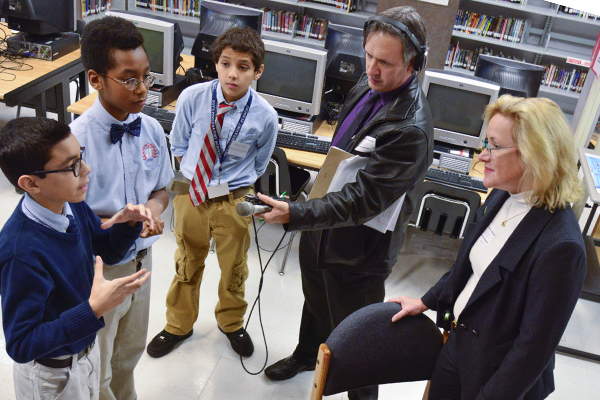Be kind, work hard and be grateful were the words of advice presented to 166 second-year medical students as they formally entered their third year of medical school at the USF Health Morsani College of Medicine’s annual Student Clinicians Ceremony, held Feb. 14.
Friends and family shared in the event, which signifies the next step in medical education for these students – when they transition from what has been primarily classroom learning to more clinical and hospital settings where they will interact with patients.
Reflecting on what the students had already accomplished and the work in the years ahead, Steven Specter, PhD, associate dean for Student Affairs, urged students to remember the human side of medicine and asked the friends and families to help them remember.
“I urge you all to ask your students what they think of the importance of humanism and patient-centered care,” Dr. Specter said.
Anthony DeSantis and Thomas Fowler each shared words of thanks and advice to their classmates and audience, reinforcing the combined strength of the two tracts in MD program.
DeSantis, who is in the Core MD Program, shared a story of when a faculty member made an effort to reassure students before a big exam, showing sincerity through both his pop-in after hours at their study sessions and his words that they would do fine. The gesture spoke volumes to DeSantis.
“You only go to one medical school, so you can constantly ask yourself if this is the right place, the right fit,” DeSantis said. “On the drive home that night, I told myself I was where I’m supposed to be.”
Fowler, who is in the SELECT MD Program, told his fellow students to look for signs of humanism.
“It’s a layer deeper than the machines we’ll use and the pills we’ll prescribe,” Fowler said, adding that they should all be kind and work hard.
“Be the doctor who helps a dad in the emergency room find a hotel room. Be the doctor who gives your cell phone number to a patient in case they have more questions. Have the kindness that’s not convenient. And don’t for a second underestimate the power of diligence.”
Frazier Stevenson, MD, senior associate dean of Undergraduate Medical Education reminded students of the change in the learning that’s to come.
“Up until now, it’s been about what you know,” Dr. Stevenson said. “But in this phase you will look at how you can apply what you know, how you share it with a team and apply it to your patients. You have worked to make yourself better, but now you’re able to bring that knowledge to other people, in a role to help people who desperately need it. You’re not shadowing. Now your knowledge is brought to bear for others, not so much for yourself.”
Providing the keynote address was Erika Abel, MD assistant professor of medicine and program director for the USF Health Internal Medicine/Pediatrics program. Taking an example from her own life, when her sister was diagnosed with a degenerative muscular disease, Dr. Abel spoke on the importance of bringing compassion and empathy when sharing bad news to families.
“Be the nice doctor,” Dr. Abel said. “Never be the doctors who says ‘go read a book about this’. And remember that it might not be the same day they need questions answered. It’s days after when they need help most.”
Providing the Humanism and Excellence in Teaching address was third-year student Trevor Lewis, who shared a poignant story of when truly listening to a patient made the difference in his patient’s limited life.
“Focus on what we have to do,” Lewis said. “It’s not about us. It’s about the patient.”
Six resident physicians were presented with Humanism and Excellence in Teaching Awards for their exceptional effort for inspiring students to be more. The exceptional teachers are Valerie Devanney, MD, Internal Medicine; Kimberly Goss, MD, Emergency Medicine; Noah Grams, MD, Pediatrics; Jaron Mark, MD, Obstetrics and Gynecology; Christian Robles, MD, Neurology; and Paul Toomey, MD, Surgery. The awards are provided by the Arnold P. Gold Foundation, which also provides a grant that supports the Clinicians Ceremony.
Before leading the students in reciting the Oath of Commitment, Bryan Bognar, MD, MPH, FACP, professor of medicine, reminded the group to also be grateful.
“You’re surrounded by folks who care,” said Dr. Bognar, who was recently named vice dean for the Office of Educational Affairs.
“You’ve all worked hard; I’ll give you that. But you’ve had support. And you’ll still need support.”
Then, putting into context the meaning of the oath, Dr. Bognar added “This oath is to help you remember the patient you are there for them. Not for you.”
With that, the Class of 2016 stood up and pledged to fulfill the principles of respect, ethics, compassion, professionalism and gratitude.
Story by Sarah Worth, USF Health Office of Communications
Photos by Rebekah Wright, USF Health Morsani College of Medicine





























































